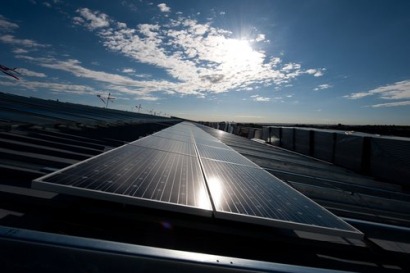
The external quantum efficiency for photocurrent, usually expressed as a percentage, is the number of electrons flowing per second in the external circuit of a solar cell divided by the number of photons per second of a specific energy (or wavelength) that enter the solar cell. None of the solar cells to date exhibit external photocurrent quantum efficiencies above 100 percent at any wavelength in the solar spectrum.
The external quantum efficiency reached a peak value of 114 percent. The newly reported work marks a promising step toward developing Next Generation Solar Cells for both solar electricity and solar fuels that will be competitive with, or perhaps less costly than, energy from fossil or nuclear fuels.
Multiple Exciton Generation key
A paper on the breakthrough appears in the 16 December issue of Science Magazine. Titled “Peak External Photocurrent Quantum Efficiency Exceeding 100 percent via MEG in a Quantum Dot Solar Cell,” it is co-authored by NREL scientists Octavi E. Semonin, Joseph M. Luther, Sukgeun Choi, Hsiang-Yu Chen, Jianbo Gao, Arthur J. Nozikand Matthew C. Beard. The research was supported by the Center for Advanced Solar Photophysics, an Energy Frontier Research Center funded by the DOE Office of Science, Office of Basic Energy Sciences. Semonin and Nozik are also affiliated with the University of Colorado at Boulder.
The mechanism for producing a quantum efficiency above 100 percent with solar photons is based on a process called Multiple Exciton Generation (MEG), whereby a single absorbed photon of appropriately high energy can produce more than one electron-hole pair per absorbed photon.
NREL scientist Arthur J. Nozik first predicted in a 2001 publication that MEG would be more efficient in semiconductor quantum dots than in bulk semiconductors. Quantum dots are tiny crystals of semiconductor, with sizes in the nanometer (nm) range of 1-20 nm, where 1 nm equals one-billionth of a meter. At this small size, semiconductors exhibit dramatic effects because of quantum physics, such as:
Quantum dots
Quantum dots, by confining charge carriers within their tiny volumes, can harvest excess energy that otherwise would be lost as heat – and therefore greatly increase the efficiency of converting photons into usable free energy. The researchers achieved the 114 percent external quantum efficiency with a layered cell consisting of antireflection-coated glass with a thin layer of a transparent conductor, a nanostructured zinc oxide layer, a quantum dot layer of lead selenide treated with ethanedithol and hydrazine, and a thin layer of gold for the top electrode.
In a 2006 publication, NREL scientists Mark Hanna and Arthur J. Nozik showed that ideal MEG in solar cells based on quantum dots could increase the theoretical thermodynamic power conversion efficiency of solar cells by about 35 percent relative to today’s conventional solar cells. Furthermore, the fabrication of Quantum Dot Solar Cells is also amenable to inexpensive, high-throughput roll-to-roll manufacturing.
Such potentially highly efficient cells, coupled with their low cost per unit area, are called Third (or Next) Generation Solar Cells. Present day commercial photovoltaic solar cells are based on bulk semiconductors, such as silicon, cadmium telluride, or copper indium gallium (di)selenide; or on multi-junction tandem cells drawn from the third and fifth (and also in some cases fourth) columns of the Periodic Table of Elements. All of these cells are referred to as First- or Second-Generation Solar Cells.
First experiment to show 100-percent-plus
MEG, also referred to as Carrier Multiplication (CM), was first demonstrated experimentally in colloidal solutions of quantum dots in 2004 by Richard Schaller and Victor Klimov of the Department of Energy’s Los Alamos National Laboratory. Since then, many researchers around the world, including teams at NREL, have confirmed MEG in many different semiconductor quantum dots. However, nearly all of these positive MEG results, with a few exceptions, were based on ultrafast time-resolved spectroscopic measurements of isolated quantum dots dispersed as particles in liquid colloidal solutions.
The new results published in Science by the NREL research team is the first report of MEG manifested as an external photocurrent quantum yield greater than 100 percent measured in operating quantum dot solar cells at low light intensity; these cells showed significant power conversion efficiencies (defined as the total power generated divided by the input power) as high as 4.5 percent with simulated sunlight. While these solar cells are un-optimized and thus exhibit relatively low power conversion efficiency (which is a product of the photocurrent and photovoltage), the demonstration of MEG in the photocurrent of a solar cell has important implications because it opens new and unexplored approaches to improve solar cell efficiencies.
Another important aspect of the new results is that they agree with the previous time-resolved spectroscopic measurements of MEG and hence validate these earlier MEG results. Excellent agreement follows when the external quantum efficiency is corrected for the number of photons that are actually absorbed in the photoactive regions of the cell. In this case, the determined quantum yield is called the internal quantum efficiency. The internal quantum efficiency is greater than the external quantum efficiency because a significant fraction of the incident photons are lost through reflection and absorption in non-photocurrent producing regions of the cell. A peak internal quantum yield of 130% was found taking these reflection and absorption losses into account.
For additional information:

